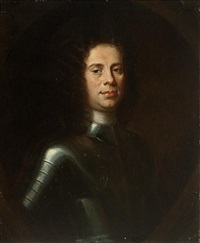William Gordon, 6th Viscount of Kenmure facts for kids
William Gordon, 6th Viscount of Kenmure (born around 1672, died 1716) was a Scottish nobleman. He was known as a Jacobite. This meant he supported the old royal family of Scotland, the Stuarts. They had been removed from the throne, and William Gordon wanted them back.
Contents
Early Life and Family
William Gordon was the only son of Alexander Gordon, the 5th Viscount of Kenmure. When his father passed away in 1698, William became the 6th Viscount. However, he could not take over his family's property until 1700. This was due to a long legal case.
William married Mary Dalzell in 1711. She was the daughter of Sir John Dalzell. Mary's brother, Robert Dalzell, was a close Jacobite friend of William's. William and Mary had three sons and one daughter.
Opposing the Union
At first, William Gordon was not very active in supporting the exiled Stuart family. But he became a leader for Scottish nobles in the Lowlands. These nobles were against the Act of Union in 1701. This Act joined Scotland and England into one country, Great Britain.
William Gordon often did not attend parliament during the reign of Queen Anne. He was busy planning a Jacobite uprising. He also hoped for an invasion from France to help the Stuarts. In 1705, other Jacobites in the Lowlands chose him to travel to France. He was meant to meet with the exiled Stuart court, but he did not go.
In 1707, James Francis Edward Stuart, the Stuart claimant to the throne, gave William Gordon the title of a marquessate. This was a higher noble rank.
The Jacobite Rising of 1715
William Gordon's brother-in-law, Lord Carnwath, encouraged him to join the Jacobite rising of 1715. This uprising was planned by John Erskine, Earl of Mar. Even though William Gordon had no military experience, the Earl of Mar made him the commander of the Jacobite forces in the Lowlands.
On October 12, 1715, William Gordon raised the Royal Banner of Scotland in a town called Lochmaben. About 200 gentlemen joined him. This small group grew as they marched. In Hawick, they heard about the English Jacobite rising. William Gordon then joined forces with Thomas Forster and James Radclyffe. Their combined group of about 150 horsemen moved towards the border.
At Kelso, they were joined by more soldiers. On October 24, 1715, William Gordon officially declared James Francis Edward Stuart as King James VIII. He then marched into England with the other rebels.
Capture and Execution
William Gordon was captured at the barricades of Preston. He was then taken to London. He was put on trial and found guilty of treason. On February 24, 1716, he was beheaded on Tower Hill. His noble title and family lands were taken away by the government. Some stories say his body was returned to his family at Kenmure for burial.
Later Years
In 1824, a special law was passed by parliament. This law reversed the punishment against William Gordon's family. His direct descendant, John Gordon, became Viscount Kenmure. It is believed that other descendants of William Gordon are still alive today. However, the title of Viscount Kenmure is currently not being used.


